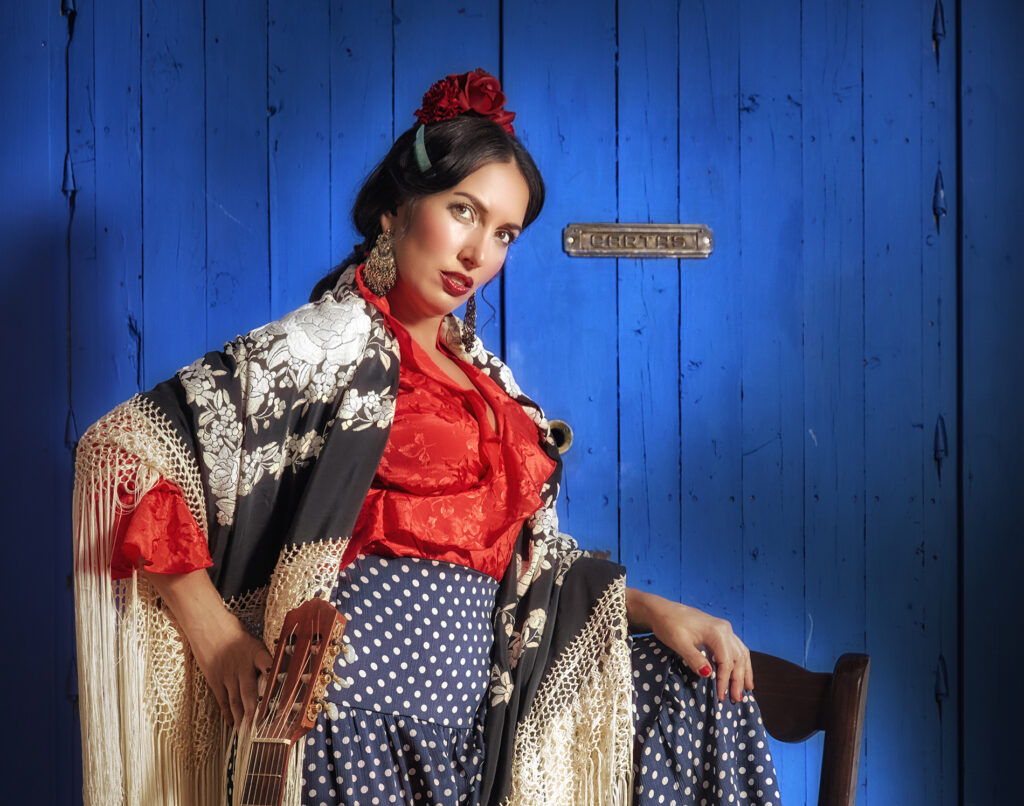
History of the flamenca dress
The flamenca dress has its roots in the 19th century, when the women of the livestock sellers in the Andalusian fairs began to wear dresses with ruffles. These dresses were practical for work, but over time, their designs became more elaborate and elegant.
Today, the flamenca dress is a key piece of Andalusian fashion, found at fairs, pilgrimages and flamenco events. Over time, this garment has evolved and has become an essential element of Andalusian fashion and tradition, thanks to its elegance and colourfulness, reflecting both tradition and modernity.
Features of the Flamenca Dress
1. Cut and Design
- Fitted to the Body: The flamenca dress enhances the female silhouette by fitting snugly from the shoulders to the knees.
- Flounces: The dress opens in flounces that can vary in size and quantity, starting from the knees. The sleeves, usually long, are also adorned with flounces.
- Neckline: Necklines can range from the classic round or V-neck to bolder and more avant-garde styles.
2. Materials and Colours
- Materials: Typically, cotton, lace, and other lightweight fabrics are used, allowing for ease of movement and dancing.
- Colours and Patterns: Dresses often feature vibrant colours such as red, black, blue, and white, with polka dots and floral prints. A wide range of colours and combinations are included in current trends.
3. Accessories
- Flowers: Placing flamenca flowers is a true art. You can position them in the hair in various ways and don’t be afraid to play with different sizes of flowers. Dare to be unique and original!
- Shawls: Often placed over the shoulders, these large silk scarves are adorned with elaborate embroideries and fringes. Shawls not only add colour and elegance but also provide warmth during fair nights.
- Combs: These are large accessories placed in the bun, typically made from materials like tortoiseshell or plastic. Combs elevate the hairstyle, adding a touch of grandeur and perfectly complementing flamenca flowers.
These elements together enhance the authenticity and beauty of the flamenca dress. They are key to highlighting the beauty of women.
Bata de Cola: An impressive element
The flamenca dress has an amazing variant called bata de cola, characterised by its dazzling tail that extends several metres behind the dancer. In addition to its stunning appearance, this garment requires skill and technique to be used correctly in the context of flamenco dancing.
Characteristics of the Bata de Cola:
- Long Tail: The highlight is the long and voluminous tail, which can reach several metres in length and is decorated with numerous frills.
- Movement and Technique: To be able to dance with a bata de cola requires a special technique, as the dancer must be able to elegantly and precisely handle the back of the dress during her performance.
- Design and decoration: The bata de cola, like the gypsy costume, is made of light materials and adorned with bright colours, lace and elaborate embroidery.
Importance in Flamenco
- Visual Spectacle: The bata de cola adds a dramatic and visually stunning touch to the flamenco show, capturing the audience’s gaze.
- Technical Challenge: In flamenco dancing, the dancers demonstrate their skill and mastery of the bata de cola through precise control and exceptional coordination.
Update on the Flamenca Dress
The flamenca dress has been updated to fit current trends while maintaining its traditional essence.
The ruffles have undergone changes in shape, size, and distribution, with asymmetrical designs and multiple layers. Necklines can be round, V-neck, or more daring like sweetheart or halter.
New fabrics such as tulle, organza, and stretchy materials are also used, providing greater comfort in addition to traditional cotton and lace. Sophistication is added with details like embroidery and rhinestone appliqués. Pastel, metallic, and neon tones have been added to the colour palette. Now, prints feature geometric, abstract, and ethnic designs, in addition to the traditional polka dots and flowers.
Tips for Choosing Your Flamenca Dress
- Comfort: Make sure the dress allows you to move freely, especially if you plan to dance.
- Personal Style: Choose colours and patterns that represent who you are and your personal style.
- Appropriate Accessories: Add flowers, shawls, and combs to your outfit to achieve an authentic and elegant ensemble.
Where Can I Buy a Flamenca Dress
In Malaga, there are many specialised shops where you can buy a flamenca dress, both in person and online. We recommend the following shops:
- El Rocío: With a wide variety of traditional and modern costumes, this shop is known for its elegant designs and high quality materials. – Calle San Juan, 1, Distrito Centro, 29005 Malaga.
- Astrid Hohle Flamenca: Specialising in personalised costumes, this shop offers exceptional customer service and a wide variety of dresses. – Calle Riotinto, 21, Nave 2, Bailén-Miraflores, 29010 Málaga
- Gitanas: They have their own style, making a difference in everything they do. Designing one by one, so that there is no other like it. – Plaza Enrique García-Herrera, 7, 29005 Málaga
Conclusion
The flamenca dress represents the culture, tradition, and art of Andalusia, being much more than just a piece of clothing. Whether at a fair, pilgrimage, or flamenco show, this dress will make you feel the rich heritage of Andalusia.
Explore the magic and charm of the flamenca dress and take a piece of Andalusian tradition with you in every flounce.
We recommend visiting El Gallo Ronco restaurant to experience the true flamenco experience. In our flamenco tablao, you can enjoy the perfect combination of gastronomy and entertainment while experiencing the magic of flamenco in an authentic atmosphere. Don’t miss out and experience a memorable night with us.




